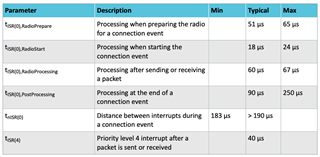SENT protocol uses a 1-wire interface to transfer data using time intervals. To receive data you simply measure the time between pulses on the wire. The transmitter never stops sending data so you must design the receiver to run continuously and record the length (time) for each pulse.
How to implement this driver with nRF52?
Our solution is to use GPIO pin, one Timer peripheral, and interrupt handler. One of the Timers is enabled and running continuous. We use PPI to start a timer capture task every time the GPIO is asserted. The GPIO also drives an interrupt to the CPU. The CPU copies the timer value to a buffer and runs the protocol. Works great.
The problems begin when you enable the SoftDevice because our interrupt handler is blocked from running whenever the SD is running. Our interrupt handler only needs to run a few instructions: Just copy the CC register to a buffer, increment the buffer index, and return. Would it be possible to run this interrupt handler at a higher priority than SD?
Another idea is to find a way to copy the CC register without CPU involvement. We looked into the PPI but could not find a way to do this.
Any other ideas?



